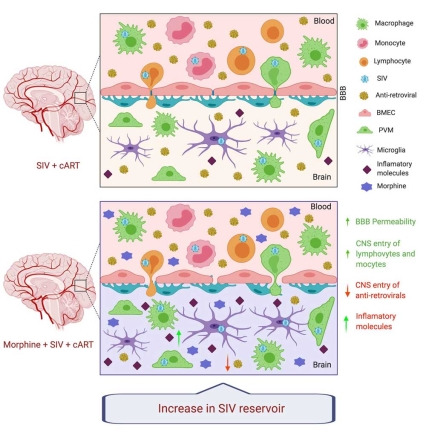Opioids are commonly misused by people infected with HIV and are known to suppress immune responses. While HIV persists in cellular reservoirs despite effective combined antiretroviral therapy (cART), the effects of opioids on viral reservoir dynamics have been unclear. Understanding these reservoirs is critical for designing more targeted HIV therapies.
Scientists funded by NIDA and the National Institute of Mental Health developed a model of morphine dependence using non-human primates infected with simian immunodeficiency virus (SIV), which causes a disease similar to AIDS in humans. Using this model, they examined how morphine modulates SIV viral reservoirs in animals treated with cART.
Among the animals that did not receive cART, they found no difference in viral loads between the morphine-dependent animals and those treated with saline. In animals treated with cART, there was a reduction in SIV reservoirs in both the periphery and lymphoid tissues in the morphine-dependent animals compared to those receiving saline. However, the latent SIV reservoir’s size was higher in the central nervous system (CNS) of morphine-dependent animals than the control animals.
These findings suggest that people with HIV who suffer from opioid use disorder may have higher viral reservoirs in the CNS than non-opioid users. This study underscores the importance of examining substance use when developing HIV eradication strategies.
Study:
- Arpan Acharya, Omalla A. Olwenyi, Michellie Thurman, Kabita Pandey, Brenda M. Morsey, Benjamin Lamberty, Natasha Ferguson, Shannon Callen, Qiu Fang, Shilpa, J Buch, Howard S. Fox, Siddappa N. Byrareddy. Chronic morphine administration differentially modulates viral reservoirs in SIVmac251 infected rhesus macaque model. Journal of Virology.
- Text Description of Illustration
- The illustration has two blocks representing the brain cells of non human primates with Simian immunodeficiency virus (SIV). Both blocks represent cells treated with combined antiretroviral therapy (cART) but one also reflects the addition of morphine (an opioid). Each block has a line across its center, representing the blood brain barrier. Colorful symbols in both blocks represent different kinds of cells and molecules, including macrophages, lymphocytes, microglia, morphine, SIV, inflammatory molecules etc. The block showing the added morphine has more SIV cells, indicating that subjects using morphine have a greater SIV reservoir in the central nervous system.

